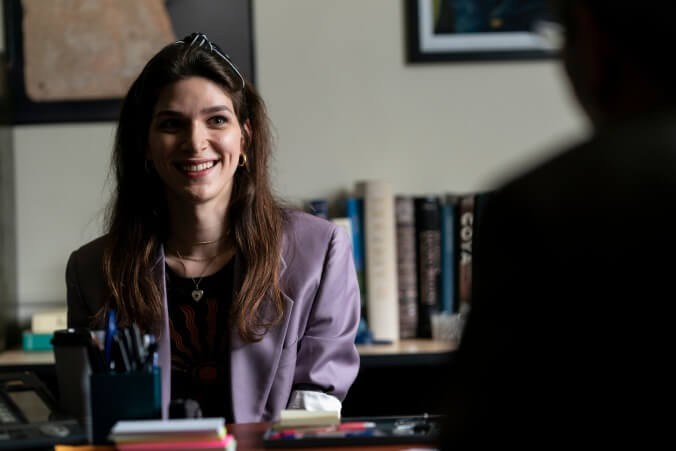Eve Lindley Photo: Jessica Kourkounis
One of the struggles in covering Dispatches From Elsewhere has been deciding how much focus to put on the game being played, largely because the show itself seems uncertain about that question. However, when it comes to the game, this week may be one of the most essential episodes yet, delving into the mythology on a whole new level. “Clara” is not all about the missing girl who’s at the center of whatever is happening—big moments for many characters do happen. But now we not only know a lot more about who Clara is, but we know the power she has to change lives, even in absentia.
The episode picks up right where last week left off, with the gang of four opening a door to a subterranean staircase. There, they discover what appears to be Clara’s abandoned apartment, with walls covered in her writing about what led her to create the Elsewhere Society—which began as a group of young folks who cared about art and defying the rules in the grim black-and-white world of Fishtown. However, in Clara’s story, she was able to bring color, especially the color blue, into people’s lives—specifically in the photorealistic murals seen both in this episode as well as previous installments.
Fredwynn is a real agent of chaos this week, most notably texting rude things to Janice’s husband’s nurse using Janice’s phone, but that’s because this new level of gameplay has enabled him to go “full Fredwynn.” This is, in some respects, an intimidating thing, but it’s also pretty wonderful to watch Andre Benjamin’s face light up as he figures out the saltpeter clue and sets Clara’s bathroom ablaze, revealing a whole new chapter of her story.
Clara, we learn, was a young woman trapped in Fishtown who found a way to escape and bond with three local youths, transforming the local neighborhood from its grey drudgery thanks to her artwork, including a waterfall mural that comes alive in front of people’s eyes. In her telling of the story, she’s quite happy to paint and revolutionize the world with her friends, but enter Octavio Coleman, who offers her all the resources she could want, if she’s willing to work for the Jejune Institute.
In the story, Clara rebels against Octavio, literally fighting off Octavio’s lieutenant with a paintbrush, but then disappearing, leaving behind just her story. (For the record, actor Cecilia Balagot packs every moment she’s on screen with charm—she actually manages to come across as a potential leader of a revolution, which isn’t necessarily the easiest thing.)
While her current state of being remains unclear, learning more about Clara has a profound impact on both Peter and Simone. In Peter’s case, her voice in his head becomes an earworm, and when he goes to work the next day, she ends up taunting him into breaking one of his company’s biggest rules, and adding The Beach Boys’ “Good Vibrations”—the first song, it seems, he’s ever really liked—to the playlist of every user on the music streaming service he works for.
The decision seems to make a lot of people happy, specifically cheerleaders and those hanging out at a barbershop. (The cowboy funeral, in fairness, finds it a bit jarring.) But that doesn’t matter to Peter’s boss, who fires Peter — though Peter basically quits in the same conversation, because he wasn’t paying attention to his boss’s “work stuff” blather, but had finally figured out that he was done with that job.
Meanwhile, Simone reconnected with her art history professor, which wasn’t nearly as seismic a moment as Peter’s firing, but did lead to her realizing that she doesn’t want to return to school, and that she’s doing a smart healthy thing right now, by focusing on figuring out what she wants to do next.
In the meantime, there’s the game, and she’s responsible for discovering a massive clue that may not solve any puzzle except the biggest one—is this real? Per an email from her former professor, the answer is surprisingly yes, as he finds proof that Clara’s mural was painted in Fishtown, 20 years ago. It’s outside evidence that there’s real magic happening here, and it has serious potential to change everything going forward. A lot of information was revealed about Clara, but there are still more mysteries to come. Despite the minimal amount of Richard E. Grant, it’s a compelling episode, thanks to how the game only gets deeper.
Stray observations
- I’d be remiss in not mentioning that Janice’s frustration with the team leads her to storm out at the end of the episode. While it’s unlikely that this is Sally Field’s last appearance on the show, we’ll have to wait until next week to find out if she’s really out of the game.
- Perhaps it’d been revealed on screen before, but this week we get a nice long look at the not-Spotify-don’t-sue service that Peter worked for, and thus learned that it’s called Manamana—a not-so-stealth Muppets reference, which is fitting given Jason Segel’s previous relationship with the franchise.
- Jason Segel’s “This is my face, inspired,” is a hilarious echo of Mulder Panic Face.
- “Why would I want to text message my face as a dragon?” Janice, I am decades younger than you, but I still understand your confusion.
- Look, I love a slow-play will-they-or-won’t-they romance, but Simone and Peter need to take their foot off the brakes, if you know what I’m saying.
- What I am saying is that they should kiss. Please kiss! Please! Soon!









































